|
|
|
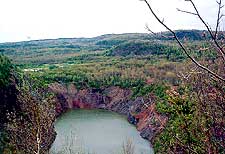 Looking to the horizon, a magnificent vista 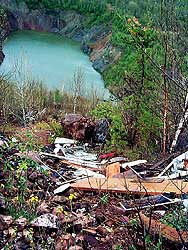 Down at our feet, this is what you see.. |
On Friday, June 11, this is what my horoscope said:... "You'll meet someone today who changes the way you look at the world. For too long, you've been seeing only part of the picture. Your cozy view is about to be shattered." Intriguing, isn't it? The person I spent Friday afternoon with was Tom Nash, Senior Area Technician, MNR, and we were visiting my favourite place, the Steep Rock pits. Now, I have waxed poetic about the astonishingly unique landscape of the pits many times before, and while this is still an underlying theme in my pits experience, it won't be the main focus of this particular article, because, as my horoscope predicted, my view of them has been expanded. I had read the 1991 report, Hazard Evaluation: Steep Rock and Caland mine areas, commissioned by the MNR on the physical hazards at the mine sites. It was a sobering read, but I was having difficulty synthesizing the information. I suggested that it might make more sense if Tom and I made a visit to see, first-hand, some of the areas of concern. Our visit on that Friday afternoon took place about 36 hours after an awesome thunderstorm that dropped massive amounts of rain on the area. |
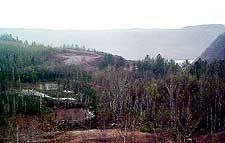 Misty rain  The road just ends, watch that first step..... 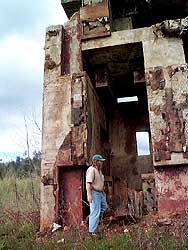 |
I learned a lot and saw a lot that I had not seen before. It is truly exciting to learn things from someone who knows more than you do. Tom shares my opinion that the pits are a great feast for the eyes, however, he knows what dangers lurk beneath the surface of the beauty.
We started off at the Errington pit. I had thought that the Errington pit had been completely filled in – not so. We hiked past the ditched and bermed road closure to the top to look into an emerald green lake in the half-filled pit. Sadly, at our feet, was a disgusting array of garbage, tumbling haphazardly down the steep side. If you looked away to the horizon, the vista was magnificent. If you looked down at your feet, you felt sick to your stomach at the baffling stupidity of people – dumping garbage here, despoiling the whole experience of the landscape when there is a perfectly good dump operating in the community. We talked a lot about this seeming idiocy, the total lack of respect this action showed to the land and to the history of Steep Rock. As we walked back to the truck, a turkey vulture lazily coasted the air currents above us. Tom showed me places where a road just ended in mid-air. An unsuspecting hiker or cyclist could easily be surprised by the abrupt end of it, the edge crumbly after the rain, especially if he / she were mesmerized by the great view. We saw evidence in the discoloured water near the cliff shores of the lake, that the recent rains had caused significant erosion of the walls. The surface of the lakes is, I learned, closed to use (under the Public Lands Act), summer or winter because of the danger of falling material from the steep sloping sides causing tidal waves. Tom has a wide range of interests and he shared his knowledge of plants, trees, and the history of MNR's involvement with the Steep Rock land. I learned about the unbelievable lengths some people will go to to get past the safety measures put in place to protect people and property, to get something for nothing, or for the transient thrill of doing something forbidden. |
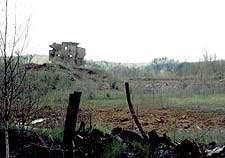 A ghostly Scottish castle??? |
The opportunities for great photographs were many and varied. The short cloudburst gave a misty glow to the pits. The derelict A2 shaft, from a distance, looked like the hulk of an ancient, abandoned Scottish castle.
And a couple of final gifts as we left the pits – tucked protectively in a damp crevice on a sun-drenched rock cliff, a tiny, perfectly red, shiningly ripe strawberry, and on the side of the road as we started home, a western painted turtle. So, at the end of the day, I have new understandings about the pits. I am more aware of the dangers that lie close to the edges, but I am also, thanks to everything that Tom Nash shared, even more awestruck by the beauty and the diversity of the pits. And perhaps even more convinced that they do have the potential to attract visitors because of their ability to tell a whole story of audacious engineering, community prosperity and slow recovery after the mine closure, and finally, nature's reclamation of a compromised landscape. The story continues. So, my horoscope turned out to be pretty accurate. Oh, I forgot, the one good thing about army worms? Because they had defoliated the fast-growing poplars, we were able to see the vistas more clearly that I had before. |
|
|